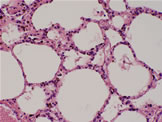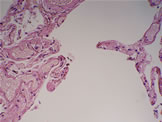Oxidants in Daily Life and Common Health Conditions
Emphysema
The lung is made up of numerous minute air sacs called alveoli, each surrounded by very thin walls. Networks of capillaries run through these walls and exchange of carbon dioxide with oxygen takes place between the blood in those capillaries and the air in the alveoli.
The alveolar walls are vested with elastic fibers so that they can stretch with inhalation and recoil with exhalation. Emphysema is a pathological condition of the lung that results from breakdown of the elastic fibers. This ultimately leads to disruption of the alveolar walls themselves, due to rupture of the alveoli from overinflation. Coalescence of alveolar spaces results in large cysts within the lung that are so characteristic of this condition (Fig. 7).
The lack of recoil in the lung tissue means a difficulty in squeezing out dirty air at the end of exhalation and the disappearance of alveolar walls means diminished areas of gas exchange. The outcome of these alterations is higher carbon dioxide and lower oxygen levels in the blood.
What takes place chemically in the destruction of elastic fibers is hydrolysis of the fibers. This is caused by the hydrolytic enzyme "elastase" secreted by neutrophils in the alveolar spaces. Normally, another enzyme called alpha 1-antitrypsin, that is produced in the liver and deployed in the alveolar spaces, inactivates elastase, helping preserve the elasticity of the lung.
One of many damaging effects of oxidants is inactivation of alpha 1- antitrypsin, thereby removing the restraint on elastase and leading to destruction of elactic fibers.
Oxidants are introduced into alveolar spaces in inhaled polluted air as well as released in situ by inflammatory cells, such as macrophages and neutrophils. Macrophges populate the alveolar spaces to scavenge dusts and pollutants contained in the inhaled air. Neutrophils are there attracted by the chemical substances secreted by macrophages.
Oxidants in inhaled cigarette smokes pass the capillary walls into blood and transiently hold up circulating neutrophils, during which time large amounts of oxidants are released into blood by the sequestered neutrophils. These oxidants pass across the capillary walls into the alveolar spaces, further raising the oxidant levels there.
The alveolar inner surfaces are covered by thin layers of fluid that contain glutathione at high concentrations, representing body's antioxidant defenses against environmental oxidants. Chronic smokers who have not smoked for 12 hours show increased levels of glutathione in this fluid, that is higher than in non-smokers. Acute smoking, however, wipes out glutathione. Smoking-related oxidants are a leading cause of emphysema.
Copyright 2006 Kuma.us


